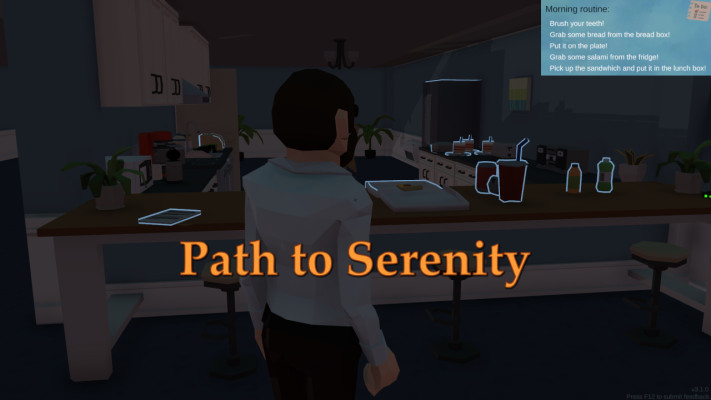Ludus Pax Studios discusses the game design process behind a story about choices and balance in Path to Serenity
segunda, 9 de junho de 2025 17h 16min

Ludus Pax Studios is preparing to launch its second game, Path to Serenity, a cozy walking simulator that takes players on a heartfelt journey through the eyes of Jim, a man torn between his career ambitions and a family he's slowly drifting away from. As the pressures of work increase, Jim begins to realize he's losing more than he's gaining. Guided by the advice of his aunt Didi, an unexpected trip to her cabin could help him rediscover the path he was always meant to follow. Scheduled to be released on June 16, 2025, we spoke with the studio to learn more about the creative process, expectations for launch, and future plans. The answers were given by Silviu Soare, BSc (Hons) in Computer Games Development, director and founder of Ludus Pax Studios.
The game explores emotional themes, particularly the challenge of balancing work and family life. When asked about the inspiration behind the story, Silviu clarified: “When asked what inspired me to tell this story, it's important to clarify that this project is a solo endeavour.”
Having worked in multiple roles throughout his career, Silviu observed firsthand how difficult it is to maintain a healthy work-life balance. “Many of my former colleagues faced similar challenges, often feeling compelled to prioritise demanding jobs over their personal lives. It wasn't always a matter of choice; the nature of the work made balance almost impossible. At some point, something had to give.”
These experiences shaped his view of how people often feel trapped in situations where sacrificing personal dreams seems inevitable. “I've met so many people who feel stuck in unfulfilling roles, afraid that choosing a different path could jeopardise their financial security.”
The story mirrors this internal conflict through the protagonist Jim. “Jim, the protagonist, represents that emotional conflict—the sadness of feeling disconnected from what matters most. But his story isn't just about family versus work; I also hope it will speak to the broader struggle of finding the right path in life.”
This personal crossroads also defined Silviu’s own journey. “I made the choice to leave behind a stable but unfulfilling path, went to university to study computer games development, and started my own solo indie studio. That decision didn't just lead me to create Path to Serenity—it allowed me to spend more time with my wife and son, and to build a life that feels meaningful.”
With its contemplative and intimate tone, the game leverages the walking simulator genre to express emotion and inner conflict. “I felt that a walking simulator was the best approach to tell this story. Giving the player direct control of Jim as he faces his inner struggle... creates a more personal connection.”
Silviu believes the slower pace of gameplay creates room for emotional immersion. “The act of walking his path—both literally and emotionally—can evoke a sense of calm as Jim begins to rediscover his peace and serenity.”
Beyond storytelling, the format also aligns with the reality of solo development. “On a practical level, choosing this genre also made sense for me as a solo developer. It allowed me to focus on the emotional depth of the story while keeping the project scope manageable and achievable.”
The game's atmosphere is shaped by carefully selected environmental elements and music. “I've tried to select music that closely complements each environment, reinforcing the story's emotional tone at every stage of the game.”
The contrast between environments is striking—from the coldness of Jim’s home and office to the warmth of nature. “In the office, I used sombre music and a grey, muted colour palette... I wanted to suggest that people have become numbers or just bodies in chairs.”
Character design also contributes to this critique of work culture. “I've used exaggerated proportions to reflect different office archetypes: some characters have oversized heads... Others have small heads... Some have long arms, always reaching for more.”
As the game progresses, lighter and more uplifting environments emerge. “Later in the game, the atmosphere shifts... The music in these small areas, which I like to call ‘Happy Places,’ changes too, becoming more uplifting and soothing.”
When asked what makes the experience stand out for players seeking lighter or more introspective games, Silviu shared his intention to offer something comforting and honest. “Path to Serenity is a cosy walking simulator—a reflective story about Jim as he tries to find inner peace and a new direction in life... I hope the game offers something meaningful to those who need it.”
He hopes players can see parts of themselves in Jim. “Whether they're playing in relax mode or reaching the more peaceful moments later in the game, I want to create a calm, soothing atmosphere where players can slow down, breathe, and reflect.”
Lastly, Silviu highlighted a meaningful initiative tied to the game’s release. “I'd also like to mention that I'm collaborating with Safe in Our World, the video games mental health charity. For every sale of Path to Serenity on Itch.io, the Humble Store, and Steam, I'll be donating $0.10 to support their important work.”



